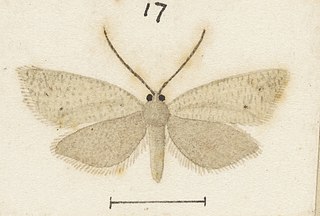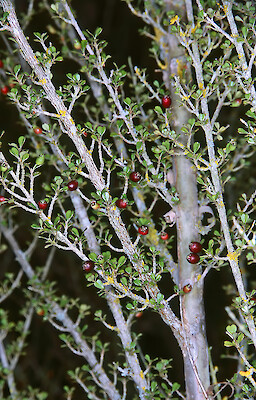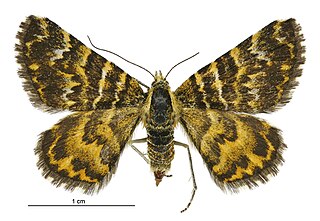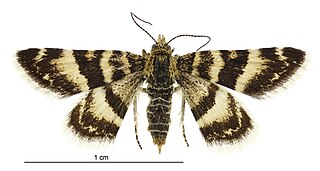
Manaaki Whenua – Landcare Research is a New Zealand Crown Research Institute whose focus of research is the environment, biodiversity, and sustainability.

Kunzea ericoides, commonly known as kānuka, kanuka, or white tea-tree, is a tree or shrub in the myrtle family, Myrtaceae and is endemic to New Zealand. It has white or pink flowers similar to those of Leptospermum and from its first formal description in 1832 until 1983 was known as Leptospermum ericoides. The flowers have five petals and up to 25 stamens which are mostly longer than the petals.

Pterophylla racemosa, known as the kāmahi, is an evergreen tree native to New Zealand. It is part of the Pterophylla genus which mostly includes sub-tropical species, but the kāmahi is found in a variety of climates in New Zealand from coastal areas, to high elevation inland areas.

Pennantia baylisiana, commonly known as Three Kings kaikōmako or kaikōmako manawatāwhi (Māori), is a species of plant in the family Pennantiaceae. It is endemic to Manawatāwhi / Three Kings Islands, around 55 kilometres (34 mi) northwest of Cape Reinga, New Zealand. At the time of its discovery just one plant remained. This single tree grows on a scree slope inaccessible to browsing goats, and has been called "the world's loneliest tree". The species was discovered in 1945 by botanist Geoff Baylis and described in 1948, although it took decades before it was it was fully accepted as a distinct species of Pennantia. Although the only wild tree is female, it was successfully propagated from cuttings in the 1950s, one of which was induced to self-pollinate in 1985. Subsequent seed-grown plants have themselves set seeds, and the species has been replanted on the island, the adjoining mainland, and in public and private gardens around New Zealand.

Ericodesma aerodana is a species of moth of the family Tortricidae. It is endemic to New Zealand and is found in the North and South Islands. The species inhabits sand dunes and larvae feed on Pimelea prostrata. Adults are on the wing from October to January and are active at twilight. This species is classified as "At Risk, Declining" by the Department of Conservation as its larval host plant is under threat from habitat loss and the invasive to New Zealand plant, sea spurge.
Kiwaia jeanae, also known as the Kaitorete jumper or mat daisy jumper, is a species of moth in the family Gelechiidae. It is endemic to New Zealand. This species is classified as "At Risk, Naturally Uncommon" by the Department of Conservation. Both the males and females of this species are brachypterous.

Pimelea villosa, also known as Pimelea arenaria, or sand daphne is a species of shrub in the family Thymelaeaceae, known in Māori as autetaranga or autetauranga. It is endemic to New Zealand. Its conservation status puts it at risk and declining, as determined by the New Zealand Threat Classification System (NZTCS). The bark of the tree was occasionally used as traditional textiles such as ribbons or ear ornaments, however was not as commonly used as the paper mulberry (aute) or Hoheria populnea (houhere).
Pimelea traversii is a species of shrub in the family Thymelaeaceae. It is native to New Zealand. The specific epithet traversii is in honor of naturalist Henry H. Travers (1844-1928), son of William Thomas Locke Travers.

Lophomyrtus obcordata commonly known by its Māori name Rōhutu or tutuhi, is an angiosperm shrub of Myrtaceae, in the genus Lophomyrtus. It is an endemic species of New Zealand, usually found in lowland forest. Lophomyrtus comes from the ancient Greek lóphos (crest), meaning bunches; and Myrtus (myrtle) meaning myrtle tree. Obcordata is associated with a heart-shaped leaf, attached to the peduncle by the pointed end.

Hibiscus richardsonii, commonly known as puarangi in New Zealand, is a species of flowering plant, a hibiscus, in the mallow family, Malvaceae. It is rare in New Zealand, and more commonly seen in eastern New South Wales in Australia. The species was named in honour of the plant collector and convict, John Richardson.

Notoreas arcuata is a species of geometer moth endemic to New Zealand. This species if found in the South Island and has been observed in the Saint Arnaud Range, around Arthur's Pass and in the Oteake Conservation Park. Larvae feed on species in the genera Kelleria and Pimelea. Adults are on the wing from December to February.

Notoreas ischnocyma is a species of moth in the family Geometridae. This species is endemic to New Zealand. This species is found in Canterbury and Otago.

Notoreas elegans is a species of moth in the family Geometridae, endemic to New Zealand. This species has a wide distribution in New Zealand and is therefore regarded as not being in need of conservation.

Notoreas isomoera is a species of moth in the family Geometridae. It is endemic to New Zealand.

Notoreas mechanitis is a species of moth in the family Geometridae. It is endemic to New Zealand.

Notoreas niphocrena is a species of moth in the family Geometridae. It is endemic to New Zealand.

Notoreas ortholeuca is a species of moth in the family Geometridae. It is endemic to New Zealand.

Notoreas perornata is a species of moth in the family Geometridae. It is endemic to New Zealand.

Notoreas simplex is a species of moth in the family Geometridae. It is endemic to New Zealand.

Veronica obtusata, the northern hebe, is a flowering plant belonging to the family Plantaginaceae. It is native to northern New Zealand, and was first described by Thomas Cheeseman in 1916.




















